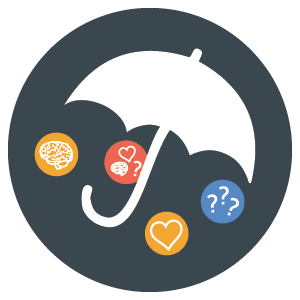The Dementia Umbrella

Dementia is the loss of cognitive functioning, the loss of the ability to think, remember, or reason, as well as loss of behavioral abilities, to an extent that it interferes with daily life. There are over 200 types of dementia, including neurodegenerative disorders, vascular dementia, and other conditions that can cause dementia-like symptoms. These disorders all fall under the “dementia umbrella.”
Read More
Neurodegenerative Disorders
Progressive and irreversible loss of neurons and brain functions
Alzheimer's Disease
Plaques and tangles in the brain relate to the most common form of dementia in those over 65.
Characteristics: Impairment in memory, language skills, visual perception, and the ability to focus and pay attention, as well as cognitive skills such as the ability to reason and solve problems.
Progression: Gradually, like a gentle slope, lasting an average of 8 years.
Prevalence: About 60% of cases.
Frontotemporal Disorders (FTD)
A family of brain diseases, FTD primarily affects the frontal and temporal lobes of the brain.
Characteristics: Affects ability to reason and make decisions, prioritize and multitask, act appropriately, and control movement. Changes in personality are often seen.
Progression: Some decline rapidly over 2 to 3 years, while others show only minimal changes for 10 years.
Prevalence: About 10% of cases.
Lewy Body Dementia (LBD)
Protein aggregates create balloon-like structures that form inside of nerve cells.
Characteristics: Early - difficulty sleeping, loss of smell, and visual hallucinations. Later - memory loss, and poor judgment (like Alzheimer’s); difficulty with movement and posture, a shuffling walk, and changes in alertness and attention (like Parkinson’s).
Progression: Early signs may proceed movement /memory issues by 10 years.
Prevalence: Very common after Alzheimer’s and Vascular dementias.
Vascular Dementia
Injuries to the vessels supplying blood to the brain.
Brain damage from multiple strokes or any injury to the small vessels carrying blood to the brain.
Characteristics: May impair language or other functions, depending on the region of the brain that is affected.
Progression: In a stair-step pattern, vascular incidents cause decline.
Prevalence: Up to 30% of cases.
Mixed Dementia
Multiple types of dementia are present.
Autopsy studies looking at the brains of people who had dementia suggest that a majority of those age 80 and older probably had “mixed dementia,” caused by both Alzheimer’s disease-related neurodegenerative processes and vascular disease-related processes.
Is It Dementia?
Many other conditions can cause dementia-like symptoms.
Other Brain Diseases can cause dementia or dementia-like symptoms, such as Creutzfeldt-Jakob Disease, Huntington’s Disease, or Secondary Dementia.
Head Injuries, such as Traumatic Brain Injuries (TBI), often sports related, or a Subdural Hematoma, bleed between brain and outer covering, can occur after a fall.
Reversible Dementias are conditions that cause dementia but can be reversed with treatment, such as metabolic disorders, infections, depression, or nutritional deficiencies.
Environmental Factors such as substance abuse, poisoning from lead, mercury or heavy metals, or Anoxia can cause dementia-like symptoms.
Infectious Diseases, namely the human immunodeficiency virus, can develop HIV-associated dementia (HAD), causing dementia symptoms.
Insight Resources
Learn More







